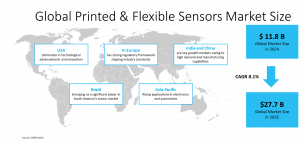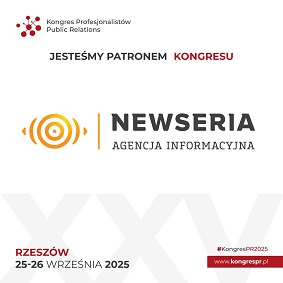Printed and Flexible Sensors Market Valued at USD 11.85B in 2024, Growing at 8.1% CAGR Through 2035
Printed and flexible sensors market was valued at USD 11,845.0 million in 2024 and is projected to grow at a CAGR of 8.1% during the forecast period (2025-2035)
Click To get a Sample PDF (Including Full TOC, Graphs & Charts, Table & Figures) @
https://www.omrglobal.com/request-sample/printed-and-flexible-sensors-market
Market Trends
Advancements In Screen And Inkjet Printing Technologies
The flexible and printed sensors market has grown exponentially as a result of improved screen and inkjet printing technologies, which have transformed the manufacturing process of the sensors. The new technologies have made it possible to produce highly efficient, cost-effective, and multi-purpose sensors that can be incorporated into a variety of applications, ranging from healthcare to consumer electronics. Being able to print the sensors on flexible substrates has given rise to wearable devices, smart packaging, and environment monitoring systems, with new options for real-time data collection and analysis. The use of inkjet printing methods has also grown more prevalent, with enhanced precision and scalability, and mass production with optimal performance not being hindered.
Rapid Increase in LFP (Lithium Iron Phosphate) in Energy Storage and EVs
The market for flexible and printed sensors is expanding at a high level, which is primarily driven by technological innovation in the automotive industry. The sensors have several benefits, such as flexibility, light weight, and being inexpensive, and as they find perfect application in advanced automotive applications. In vehicles, the sensors find application in various systems, including driver-assistance systems, health monitoring, and interior climate control. The increasing use of electric vehicles (EVs) and autonomous driving functionalities is also raising the demand for flexible sensors as they are tasked with enhancing the performance and safety of cars. The increased focus on lowering the weight of vehicles to enhance fuel efficiency and decrease emissions also coincides with the advantages of flexible sensors. Their potential to be easily integrated into car interiors, for instance, in touch panels and smart displays, is also helping fuel their growing popularity.
Regional Outlook
Strong Presence of Key Market Players in North America
The North American flexible and printed sensors market is witnessing significant growth driven by rising demand in some of the key industries such as healthcare, automobile, consumer electronics, and industrial processes. The growth is primarily driven by the rising use of smart and wearable devices, where light, thin, and flexible sensors deliver some of the key design and functional benefits. Inclusion of Internet of Things (IoT) technology in consumer items has accelerated further the demand for small, energy-efficient, sensing solutions. Furthermore, advances in printing technologies, including inkjet and screen printing technologies, have enabled their cost-effective manufacture in bulk quantities. Automotive and automotive systems manufacturing are relying ever more heavily on flexible sensors used in driver assistance and in monitors for internal systems.
Order Your Report Now For A Swift Delivery
Asia-Pacific Holds Major Market Share
The Asia-Pacific market for printed and flexible sensors is expanding vigorously owing to increasing demand from various industries such as healthcare, consumer electronics, automotive, and industrial automation. Advancements in technology and miniaturization of electronics have encouraged the application of flexible sensors in wearable devices and smart fabrics. Growing research and development investments by governments as well as private companies are fueling market growth. The increasing popularity of smart manufacturing and the Internet of Things (IoT) is driving demand for these sensors, as they deliver precise, real-time information in a lightweight, cost-efficient format. China, Japan, South Korea, and India are leading the way in terms of innovation and volume production. The company offering products in the region is Nissha Co., Ltd., Japan, with a variety of printed and flexible sensors for usage in automotive, healthcare, and consumer electronics applications.
Market Segmentation and Growth Areas
Biosensors Segment is Expected to Dominate the Market, Holding the Largest Share
The printed and flexible sensors market has experienced strong growth over the past few years, led by the increasing demand for biosensors in medical diagnostics and healthcare. Printed biosensors have benefits of low cost, flexibility, and ease of integration into disposable and wearable devices. The sensors are being used more and more for real-time monitoring of health, glucose sensing, and disease diagnosis, improving patient outcomes through early detection. The increasing trend of individualized health care and the emergence of point-of-care testing solutions are also driving market growth. Developments in print materials and print technologies have allowed for the realization of miniaturized, highly sensitive biosensors. Even integration of the Internet of Things (IoT) into health devices is also driving the utilization of printed biosensors for telemonitoring. For instance, Abbott Laboratories provides a flexible wear-on-body glucose monitoring system by the name FreeStyle Libre using printed biosensor technology to enable continuous glucose monitoring.
The Medical Devices Segment is Expected to Capture a Significant Share of the Market
The expansion of the printed and Flexible Sensors Market within the medical devices industry is driven mainly by the growing demand for compact, light-weight, and economical sensing technology. Such sensors are especially apt to be incorporated in wearable medical devices to continuously monitor and non-invasively monitor vital signs, including heart rate, temperature, hydration status, and breathing patterns. Their flexibility and compatibility to adapt to various surfaces make them ideal for patient-friendly applications, where better comfort and usability are achievable. In addition, printed sensors are propelling the miniaturization of medical devices, fueling the trend for handheld and home-use health monitoring equipment. Increased prevalence of chronic illnesses and an aging global population fuel the need for real-time, effective diagnostic equipment. Promotion by regulatory bodies to fuel medical device innovation fuels the use of these new-generation sensors.
Request for Customization: https://www.omrglobal.com/report-customization/printed-and-flexible-sensors-market
Market Limitations and Challenges
•Sensor Sensitivity: Even with improvements in the print technology, it is difficult to raise the production level to meet global needs without compromising on the consistent quality and performance. Heterogeneity during the printing process and raw materials may affect the performance of final sensor products.
•Lack of industry standards: There are no industry-recognized standards and certifications for the flexible and printed sensor market, which can act as a barrier to entry into the market. Without standard test practices or performance standards, customers may be reluctant to adopt the technology.
Market Players Outlook
The major companies operating in the global Printed and flexible sensors market include ALPS ALPINE CO., LTD., ELANTAS GmbH, Mekoprint A/S, Nissha Co., Ltd., and Yokogawa Electric Corp. among others. Market players are leveraging partnerships, collaborations, mergers, and acquisition strategies for business expansion and innovative product development to maintain their market positioning. For instance, Interlink Electronics, Inc. provides Force-Sensing Resistors, a form of printed and flexible pressure sensor applied in robotics, medical equipment, and consumer products. FSR 402 – a round sensor whose resistance varies with applied force. Flexible and thin, and well-suited for embedded applications.
Recent Developments
•In January 2025, Allegro MicroSystems, Inc., solutions for sensing and power motion control, and system solutions that are energy-efficient, announced two new current sensor ICs, the ACS37030MY and the ACS37220MZ. The ICs, which are based on Allegro's advanced sensing technology, feature low internal conductor resistance, high bandwidth operation, and robust performance in a broad range of automotive, industrial, and consumer applications.
•In December 2024, Smartkem, transform the global of electronics with its new organic thin-film transistors, entered into a multi-year agreement with FlexiIC, a firm offering innovation in flexible integrated circuit and system design, to start a new project to create a new generation of CMOS for smart sensors.
•In July 2024, Monod Bio, a life sciences company using AI to generate new proteins for the research use only (RUO) and in vitro diagnostics (IVD) markets, announced the launch of the NovoLISA, a rapid biosensor assay platform that delivers results in just 15 minutes—drastically reducing the time to result when compared with alternative methods, such as the ELISA assay platform often used in RUO settings. The name of the platform, NovoLISA, stands for "de Novo protein-Linked Instantaneous Solution-based Assay". The Company is launching the NovoLISA platform with its first offering of a C-Reactive Protein (CRP) assay.
Some of the Key Companies in the Printed and flexible sensors Market Include-
• ALPS ALPINE CO., LTD.
• Brewer Science, Inc.
• Butler Technologies Inc.
• CTS Corp.
• e2ip technologies
• ELANTAS GmbH
• Forciot
• Hoffmann + Krippner GmbH & Co. KG
• KWJ Engineering, Inc.
• Martin Technologies
• Mekoprint A/S
• Memtronik
• Murata Manufacturing Co., Ltd.
• Nano OPS, Inc.
• NANOPAINT, LDA
• Nissha Co., Ltd.
• PolyIC GmbH & Co. KG
• QUAD INDUSTRIES
• Roos GmbH
• Saralon GmbH
• STATIC ELECTROTECH LLP.
• Witte Technology GmbH
• Yokogawa Electric Corp.
Printed and flexible sensors Market Segmentation Analysis
Global Printed and flexible sensors Market by Type
• Biosensors
• Capacitive
• Piezoelectric
• Piezoresistive
• Others (Proximity Sensor)
Global Printed and flexible sensors Market by Technology
• Inkjet Printing
• Flexographic Printing
• Screen Printing
• Gravure Printing
Global Printed and flexible sensors Market by Application
• Automotive
• Consumer Electronics
• Environmental Testing
• Industrial Equipment
• Medical Devices
• Packaging
Regional Analysis
• North America
o United States
o Canada
• Europe
o UK
o Germany
o Italy
o Spain
o France
o Rest of Europe
• Asia-Pacific
o China
o India
o Japan
o South Korea
o ASEAN Economies (Singapore, Thailand, Vietnam, Indonesia, and Other)
o Australia and New Zealand
o Rest of Asia-Pacific
• Rest of the World
o Latin America
o Middle East and Africa
Inquiry Before Buying: https://www.omrglobal.com/inquiry-before-buying/printed-and-flexible-sensors-market
Anurag Tiwari
Orion Market Research Pvt Ltd
+ +91 91798 28694
email us here
Visit us on social media:
LinkedIn
Facebook
X
Legal Disclaimer:
EIN Presswire provides this news content "as is" without warranty of any kind. We do not accept any responsibility or liability for the accuracy, content, images, videos, licenses, completeness, legality, or reliability of the information contained in this article. If you have any complaints or copyright issues related to this article, kindly contact the author above.
Understanding Wrongful Death Claims in Louisiana: Key Legal Information for Families Facing Loss
Dashcams and Personal Injury Litigation: Legal Insights from Morrow Law Firm on the Role of Video Evidence
AIOps Market Growing at 37.90% CAGR | Reach USD 644.96 Billion by 2030 Globally
Kalendarium
Więcej ważnych informacji
 Jedynka Newserii
Jedynka Newserii

 Jedynka Newserii
Jedynka Newserii

Transport

Polska przeciwna przedłużeniu umowy UE–Ukraina o transporcie drogowym. Uderza ona w krajową branżę transportową
Parlament Europejski większością głosów poparł przedłużenie umowy o transporcie drogowym między Unią Europejską a Ukrainą do końca 2025 roku. Zdaniem polskich europosłów, którzy głosowali przeciw, podtrzymanie liberalizacji przewozów drogowych przyczyni się do dalszego obniżenia konkurencyjności polskich firm transportowych. W przeciwieństwie do ukraińskich przewoźników muszą one spełniać szereg unijnych wymogów. Polska delegacja planuje przedstawić swoje stanowisko europejskiemu komisarzowi ds. zrównoważonego transportu i turystyki.
Transport
M.Kobosko: Wszyscy zapłacimy za eskalację między Izraelem a Iranem. Kraje UE powinny robić więcej dla budowy swojego własnego bezpieczeństwa

– Mrzonki o armii europejskiej są mrzonkami, to trzeba sobie jasno powiedzieć. Każdy z krajów członkowskich Unii Europejskiej musi, i to się na szczęście już dzieje, nie tylko myśleć i mówić, ale też robić coraz więcej dla budowy swojego własnego bezpieczeństwa w koordynacji wspólnej – uważa Michał Kobosko, poseł do Parlamentu Europejskiego z Polska 2050. W kontekście światowych konfliktów, w tym na linii Izrael–Iran, jego zdaniem Polska powinna się skupić na współpracy zarówno ze Wspólnotą, jak i Stanami Zjednoczonymi.
Muzyka
Trwający Festiwal Mozartowski przyciąga tłumy melomanów. To jedno z najważniejszych wydarzeń w stolicy

Artystka zaznacza, że za sprawą Warszawskiej Opery Kameralnej jeszcze przez dwa tygodnie Warszawa będzie rozbrzmiewać Mozartem. Kolejna edycja festiwalu poświęconego temu wybitnemu kompozytorowi zajmuje ważne miejsce w kulturalnym kalendarzu stolicy i przyciąga tłumy melomanów. A przed nimi jeszcze sporo atrakcji. Alicja Węgorzewska szczególnie zaprasza na dwie premiery, jedną skierowaną do młodych odbiorców, drugą – dedykowaną koneserom. Niezwykle ciekawie zapowiada się także nowy sezon artystyczny w WOK-u. Twórcy już pracują nad kolejnymi spektaklami i nagrywają nowe płyty.
Partner serwisu
Szkolenia

Akademia Newserii
Akademia Newserii to projekt, w ramach którego najlepsi polscy dziennikarze biznesowi, giełdowi oraz lifestylowi, a także szkoleniowcy z wieloletnim doświadczeniem dzielą się swoją wiedzą nt. pracy z mediami.









.gif)

 |
| |
| |
|